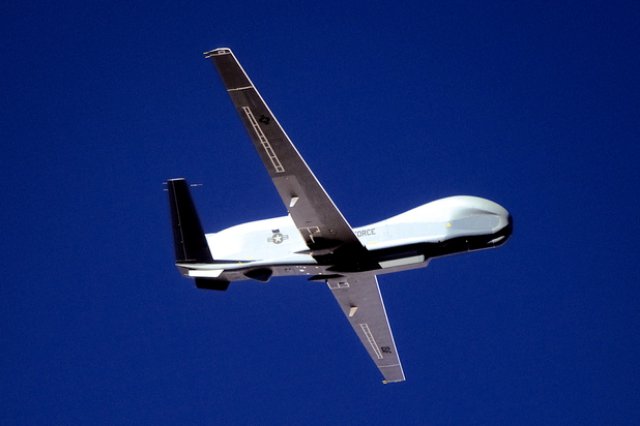The 412th Test Wing’s Global Vigilance Combined Test Force received a Global Hawk Block 40 Aug. 6, on loan from Air Combat Command. The aircraft, from Grand Forks Air Force Base, North Dakota, is joining the Block 20 and 40 aircraft at Edwards AFB to offer an additional platform for configuration-constrained testing, allowing the test force to balance their schedule.
The Block 40 aircraft will test upgrades for the diminishing manufacturing source, or DMS, – the loss or impending loss of manufacturers of items or suppliers of items or raw materials – and additional scope systems including Inmarsat and multi-platform mission control segment hardware and software integration. The Inmarsat I3 system will be upgraded with a more advanced Inmarsat I4 system.
The aircraft should be ready for use by the first week in September and is on loan through January. Though the Block 40 is not instrumented to collect telemetry data, it “fits perfectly” for testing the DMS upgrades.
“Air Combat Command was willing to loan us (the aircraft) to utilize a dedicated air vehicle due to configuration constraints incurred during Inmarsat testing,” said Teresa Bennett, the GVCTF Global Hawk program manager. “The importance of Inmarsat testing is that in the end of calendar year 2016, if we don’t make these modifications across the fleet, our fleet faces potential grounding.”
The additional jet will allow GVCTF to press forward with current developmental testing as well as focusing on the new modifications that will support ACC in the long run. The modernization is part of an effort to prepare the Global Hawk as it enters a sustainment mode.
“The big picture is that we’re finalizing our path to Initial Operational Test and Evaluation on the Block 40 air vehicle and sharing assets across the enterprise allows continuity of developmental test to ensure we provide improvements to the warfighter,” Bennett said.
According to Bennett, the additional Block 40 will incur minimal costs for Edwards AFB because it will not increase the flight operations tempo. Instead, it will allow the jet to keep its configuration rather than having the maintainers swap back and forth between the various configurations.
Global Hawk is also being used as surrogate platforms to test software that the Air Force may not have purchased yet.
Currently, GVCTF is using its Block 40 Global Hawk to test maritime modes for NATO using targets from Naval Air Station Point Mugu, California. The newly loaned Block 40 will allow the NATO project to remain on schedule.
“There are a lot of projects using our current air vehicle, that’s all the more reason why it’s so valuable to have another air vehicle to allow deconfliction,” Bennett said.
Previously, the GVCTF had an Airborne Signals Intelligence Payload Block 30, but it was given to the ACC when the operational need was deemed more important than testing. In addition to the ASIP Global Hawk, GVCTF also relinquished a launch and recovery element for operational use.
“ACC is offering out their hand saying, ‘We understand you have a need, here, take an air vehicle and test the capability we desperately need,'” Bennett said. “The Global Hawk Program Office is doing a great job of working with Air Combat Command and developmental test to share the assets to ensure the warfighter is getting what they need in the time they need it.”
Bennett said they hope to receive a launch and recovery element from Northrop Grumman’s U.S. Air Force Plant 42 site in Palmdale, California in fall 2014, that will offer a longer term solution to scheduling conflicts.
The Northrop Grumman-built Global Hawk is an unmanned aerial vehicle, or UAV, designed for reconnaissance and surveillance. It was the first unmanned, powered aircraft to cross the Pacific Ocean in 2001, and holds the endurance record for a full-scale, operational unmanned aircraft with a 34.3 hour flight reaching altitudes up to 60,000 feet.
“We can fly at high altitudes so we’re not as easily detected as some of the other platforms out there,” Bennett said. “We can fly longer, up to 32 hours, without refueling. It’s a great asset to the Air Force; it helps give an essay to the troops on the ground.
The military is not the only organization that has benefitted from the real-time updates. In recent times, a Global Hawk UAV aided in a search for Nigerian girls who had been kidnapped as well as assisting firefighters during the San Diego wildfires.
“Global Hawk is one of the top rated surveillance remotely piloted aircraft right now,” Bennett said. “There’s a lot out there. We don’t have the same weapons systems that the other platforms have. But we are the leading platform for endurance and surveillance, providing precise weapons targeting and better protection of friendly forces.”

